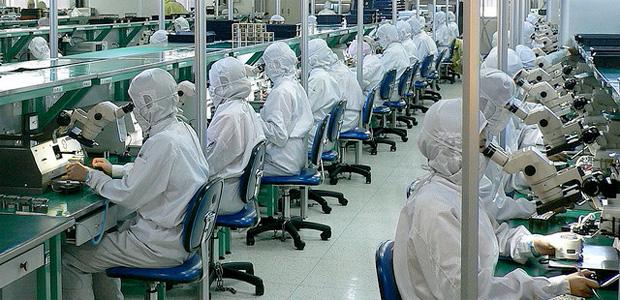Why China May Lose Manufacturing Jobs to the US
Manufacturing in China (Photo: jurvetson)
The company SolarWorld had a choice a few years back: build solar panels in China or open a new factory in Hillsboro, Oregon.
The company could’ve paid workers a lot less in China. But it went with Oregon.
At the Oregon factory, I asked company spokesman Ben Santarris, why not do this in China?
“Why don’t you move to China?,” retorted Santarris. “That’s actually what we say to investment analysts when they ask the same question. We say, ‘Why don’t you go ahead and move to China?'”
Santarris said the company is committed to western labor and environmental standards, standards that China doesn’t match.
But SolarWorld is still a business, one that’s beholden to shareholders. Santarris said they did some math and came to the conclusion: We can make this work in Oregon without relying on cheap Chinese labor.
“Labor accounts for less than 10 percent of our cost. Of those costs, we believe close to half is lost to the Chinese by greater shipping costs. Another half, or more, is made up for by the higher US labor productivity.”
American workers are generally more productive because they work with better machines and tend to be better trained.
That said, Chinese workers put in a lot more hours at lower cost. So it’s still cheaper today to manufacture in China.
SolarWorld is trying to fight those economics. Yesterday, the company and six other American solar manufacturers filed a trade case in Washington at the Commerce Department against the Chinese solar industry. They’re seeking high tariffs on Chinese imports. The companies say they need protection to compete with China and build in America.
Some business analysts say it’s time for more American companies, across different industries, to consider manufacturing stuff back home. Mark Kramer, managing director at the consulting firm FSG in Boston, said outsourcing to China is not a slam dunk anymore.
“When you take into account the added costs of transportation, the additional lead time that’s necessary to change your stock and therefore the larger inventories you need to hold here. And the risks of things like the lead paint recall for toys that cost Mattel $30 million, there really are a tremendous number of costs to outsourcing.”
American companies may have another reason to think twice about setting up shop in China: rising wages for Chinese workers. Hal Sirkin with the Boston Consulting Group is co-author of a new study “Made in America, Again: Why Manufacturing Will Return to the US.” He said 15 years ago, workers in China earned 50 cents an hour.
“And that 50 cent an hour labor is now that $3 an hour labor,” said Sirkin, who adds that Chinese wages are going up 17 to 20 percent a year.
So, Sirkin thinks that in less than five years it will make just as much business sense for some American companies to build things back home, particularly in lower-wage southern states.
“Now of course because factories are 25, 30-year assets, companies are going to need to make the decisions now as to where they want to produce things.”
A few companies have already moved their operations back from China. For example, a headphone manufacturer relocated to Florida and a producer of ATM’s is heading to Georgia. Still, there hasn’t yet been a mass homecoming. And University of New Hampshire economist Ross Gittell said, don’t look for one.
“Because if you compete on lower cost, those jobs are not going to go to China, they’re going to go to even lower cost countries than China, Indonesia, and lesser developed nations where lower wages are going to be the source of competitive advantage.”
But Gittell said that doesn’t mean all manufacturing has to be surrendered to overseas competition. He said higher-tech jobs that require more machinery, jobs such as building solar panels, can flourish in the US.
“Yes, but we have to start investing in clean technology innovation and a workforce right now, which is what China is doing! So we’re losing the jobs over the next 20 years to China now and there’s something we can do about it.”
So why aren’t we doing more about it? President Obama has called for more investment in manufacturing across the board. His critics say the administration lacks a clear strategy.
Mark Kramer said business executives are also to blame, chasing short-term profits when making business decisions.
“Investors looking at quarter by quarter results, did you miss your earnings projections by a penny? The fact that CEO’s have a shorter average tenure nowadays, they’re there just for a few years, most of their compensation is in the stock. Many of the activities that are more socially responsible and are better for the business in the long run, actually achieve their benefits in the long run, over a period of three, five or 10 years.”
Consumers also have a role to play if we’re going to shift manufacturing back home, said Lisa Margonelli at the New American Foundation.
“We’re going to have to come to terms with a new sense of what globalization mean to us. What it’s meant to Americans is: It’s all about price. You know for 10 or 15 years we all bought really cheap deck chairs from China. And that seemed to be working kinda well; we have to decide whether that’s what we care about.”
If manufacturing does start shifting back, some things are going to cost more. There’s no way around that. But even if manufacturing stays in China, with economic trends over there, Chinese-made products will inevitably cost more too.
